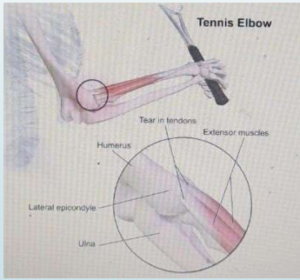B. Wrist extensors – Explanation
this condition, there is pain where the common extensor tendon arises from the lateral
epicondyle of the humerus. The muscle group that is affected are the wrist extensors.
Why is the answer not forearm extensors?
The primary condition affects the extensors of the forearm and the specific muscle that
is affected is the extensor carpi radialis brevis muscle. Although this muscle is located
in the forearm, its function is to extend and abduct the wrist. Since the question asks for
which muscle group is affected, the answer of wrist extensors is therefore correct.
The fact that this person is a painter is a huge clue as the motion of using a paint brush
or paint rollers creates stress at the insertions of the extensor muscles which are
located at the lateral epicondyle. Painters generally lift heavy objects and heavy tools in
a repetitive motin which worsens the symptoms of tennis elbow. The combination of
tenderness at the lateral epicondyle and pain upon resisted wrist extension are
indicative of a tennis elbow.
TENNIS ELBOW
Remember, tennis elbow does not always have to happen in tennis players and the
other term for it which is lateral epicondylitis is not strictly correct either but there are no
better terms to use for this condition.
Tennis elbow is causd by overuse and partial tearing of the extensor digitorum muscles
which typically cause tenderness over its insertion at the lateral epicondyle of the
humerus.

Tennis elbow is developed by doing any form of activity that involves repeatedly twisting
your wrist and using your forearm muscles. Some examples:
- Playing racquet sports
- Using shears while gardening
- Using a paint brush or roller while decorating
- Activities that involve fine, repetitive hand and wrist movements
Examination would likely reveal tenderness at the lateral epicondyle and pain (again at
the lateral epicondyle) on resisted dorsiflexion of the wrist.
It is a self limiting condition. However, it can often last for several weeks or months.
The treatment involves rest to the injured area, cold compress, avoiding activities that
strain affected muscles and tendon. Painkillers such as Paracetamol and NSAIDs may
help ease mild pain and inflammation. Other treatments involve physiotherapy.
